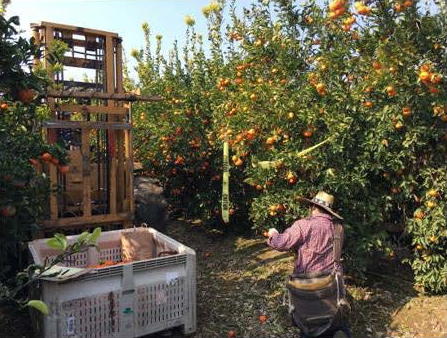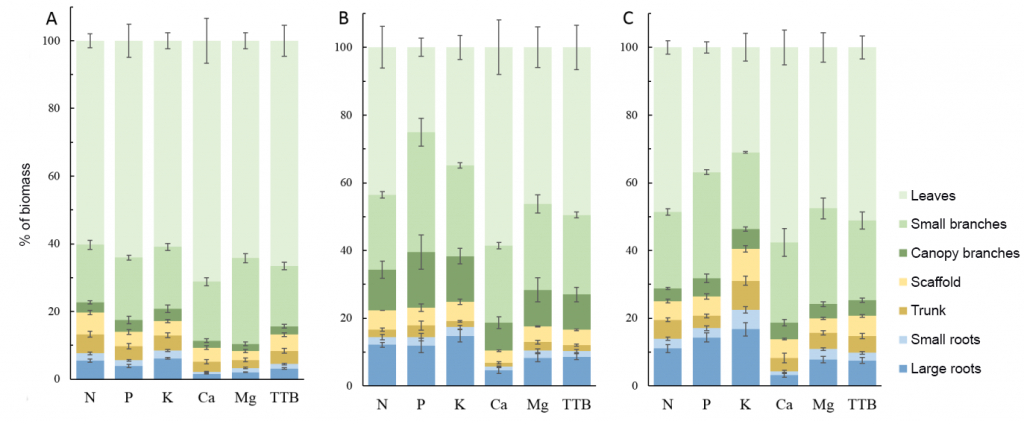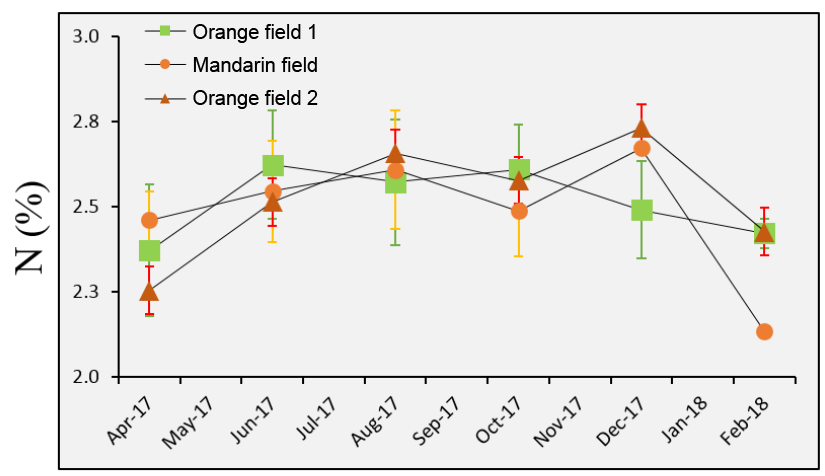Research Update: Developing Nutrient Budget and Early Spring Nutrient Prediction Model for Nutrient Management in Citrus
Project leaders: Patrick Brown and Douglas Amaral
Project location: Fresno, Tulare and Ventura Counties
Year of study: 2 of 3
Overview: Leaf analysis with critical value* interpretation is a common practice for determining nutrient applications in citrus. However, this practice can lead to over-application of nutrients and excess nitrogen (N) loss due to their insensitivity to over-fertilization. This ongoing project aims to develop nutrient demand curves, an early season leaf sampling protocol, and nutrient prediction model for mandarin and orange groves. Preliminary results indicate that small branches and leaves account for the majority biomass in trees and the shoots have the highest rate of nutrient accumulation before June. Accumulation of nutrients continues between June and October, but at a decreased rate.
Issue: In the United States, most citrus is produced in Florida and California. However, there have been limited research studies conducted in California on total N demand of citrus species. Additionally, previous research can be insufficient due to variances such as climatic differences, reduced efficiency goals or simply being outdated. Given increasing regulatory pressures, growers need more precise data pertaining to season, species and yield-dependent information on N uptake in citrus.
While critical value can provide information on nutrient adequacy or deficiency in the plant, it has minimal information on appropriate fertilizer rates or application timing. This method is sensitive to deficiencies, but not to over-fertilization. The critical value method may also not provide enough time to respond appropriately to in-season deficiencies. A more appropriate method to inform nutrient decisions may be through nutrient budgeting. This approach requires early season estimation of expected yield, tree nutrient status, updated mid-season yield estimate, and in-season adaptation of N applications.
Approach: This project will create a phenology-based nutrient prediction model for mandarin and orange. With the data collected through this project, the principle investigators (PIs) are developing demand curves and early season leaf sampling protocol. This protocol will guide the quantity and time of fertilizer application for these crops. The PIs are achieving this through intensive monitoring of highly productive groves of mandarin and orange in Fresno and Tulare counties.

To develop nutrient demand curves, researchers are excavating whole trees of each species in spring, before flowering, and at the end of the first and second seasons. They are partitioning the trees to determine biomass accumulation and nutrient uptake and distribution. For each of the excavated trees, the researchers divide them into the following parts for analysis: roots, trunk, scaffold, canopy, branches and leaves. They are also monitoring trees of each species for changes in yield and nutrient concentrations in different organs throughout the season.
Finally, the researchers are conducting extensive leaf sampling and analysis. Through this work, they are collecting and analyzing leaf samples from 25 orchards across Tulare, Fresno and Ventura counties. They are collecting leaves in the spring and summer months and analyzing them for macro and micro nutrients.
Preliminary results:
Please note, the data shown in this report are preliminary data from year one and two, of a three-year project, and no conclusive data are shown. Preliminary results show that small branches and leaves accounted for most of the biomass in both orchards and included a large fraction of nutrients present in aboveground tissues (Figure 2).

In general, the shoots accumulated nutrients rapidly until the end of June, and continued afterward, but at a lower rate. Researchers did not observe net accumulation of nutrients in the shoots after late October/early November. From December to February, the amount of nutrients present in the tree canopy remained stable or decreased (Figure 3), likely suggesting nutrient translocation to perennial organs. The seasonal demand of nutrients in orange was high early in the season from May through July suggesting that nutrients should be available in the soil for uptake by citrus trees from April to November.

For upcoming outreach events related to this project, and other FREP-funded research, please subscribe to the FREP Calendar (https://blogs.cdfa.ca.gov/FREP/index.php/calendar-4/).
*Critical Value is the nutrient concentration in a standard leaf sample at which yield is 90% of the maximum.


